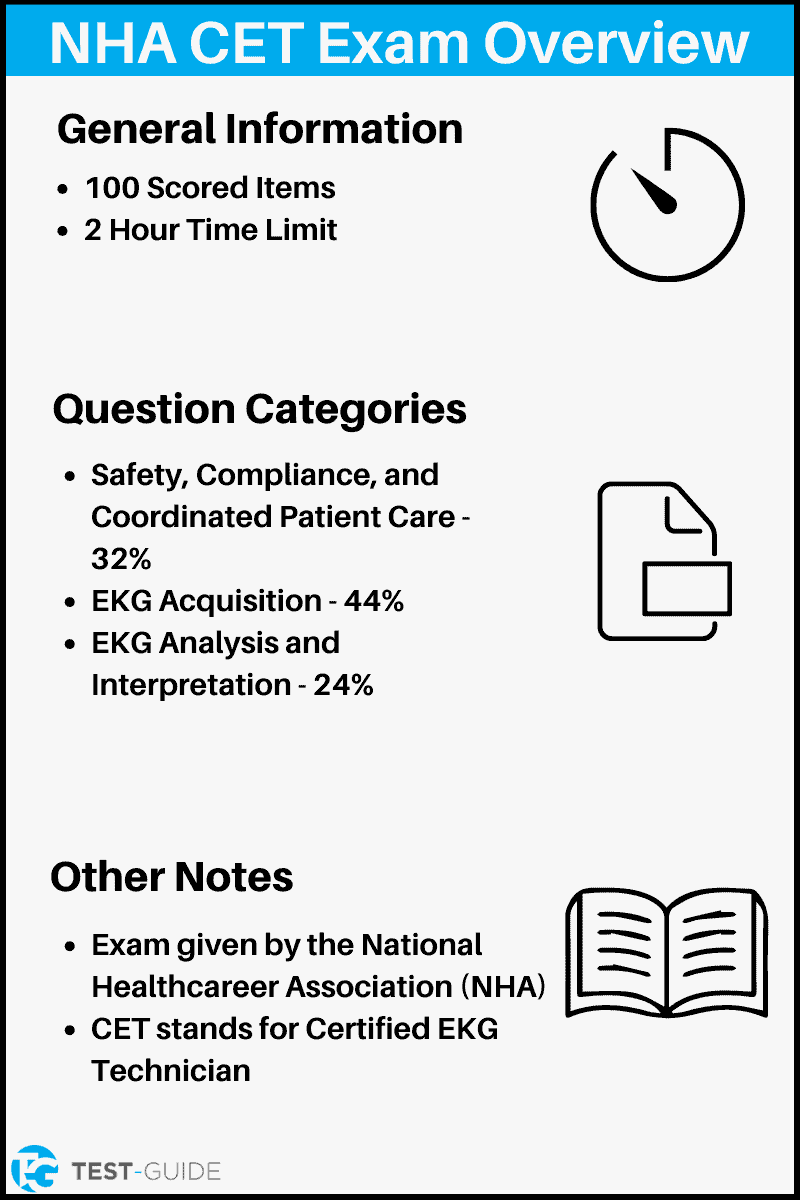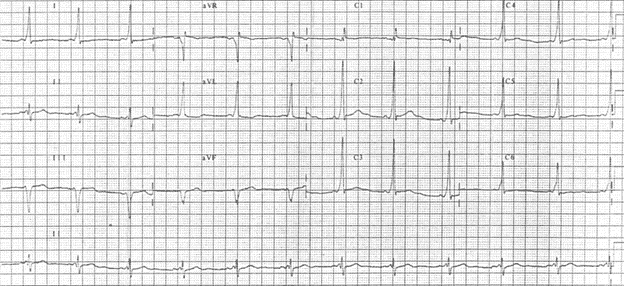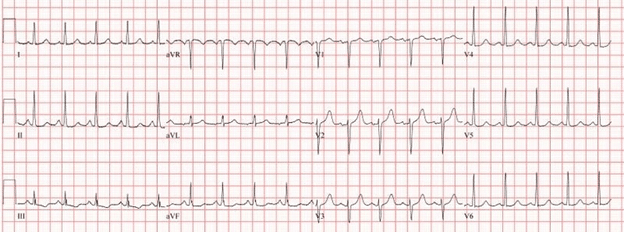All EKG Practice Tests
Take an EKG practice test listed below to help you get started. We highly recommend you take one before creating a study plan so that you know where to focus your studies.
EKG Practice Strips
One of the most difficult parts of the EKG exam is identifying EKG strips. This is an area that requires practice in order to master. Here are some free resources to help you get started.
| Resource | Notes | Provider |
| EKG Practice Strips 1 | Review 175+ EKG practice strips | Monitor Tech |
| EKG Practice Strips 2 | Review sample EKG strips | Key Med Info |
EKG Strips You Should Know
Here is a list of all the EKG strips that you should know before taking your EKG certification exam.
| Accelerated Idioventricular Rhythm | Accelerated Junctional Rhythm | Asystole |
| Atrial Fibrillation | Atrial Flutter
| Bundle Branch Block |
| First Degree Heart Block | Idioventricular Rhythm | Junctional Escape Rhythm |
| Junctional Tachycardia | Multifocal Atrial Tachycardia | Normal Sinus Rhythm |
| Pacemaker Failure to Capture | Pacemaker Failure to Pace | Pacemaker Single Chamber Atrial |
| Premature Atrial Complex | Premature Junctional Complex | Premature Ventricular Complex |
| Premature Ventricular Complex Bigeminy | Premature Ventricular Complex Quadrigeminy | Premature Ventricular Complex Trigeminy |
| Second Degree Heart Block Type I | Second Degree Heart Block Type II | Sinoatrial Block |
| Sinus Arrest | Sinus Arrhythmia | Sinus Bradycardia |
| Sinus Bradycardia | Sinus Tachycardia | Supraventricular Tachycardia |
| Third Degree Heart Block | Ventricular Fibrillation | Ventricular Tachycardia |
| Ventricular Tachycardia Monomorphic | Ventricular Tachycardia Polymorphic | Ventricular Tachycardia Torsade de Pointes |
| Wandering Atrial Pacemaker | Wolff-Parkinson-White Syndrome |
What is an EKG?
An EKG (electrocardiogram test) is a noninvasive procedure that measures electronic signals in the heart to ensure that it’s functioning normally. It’s simple and painless, detailing the rate and strength of each heartbeat.
Physicians use this important test to diagnose major problems with the heart such as arrhythmias or coronary artery disease, or to monitor how certain treatments such as medications or pacemakers are working.
An EKG identifies the following heart disorders:
- Arrhythmia (irregular heartbeat)
- Blocked arteries
- Risk of heart disease
- Risk of heart failure
- Previous heart attacks
- Other forms of damage to the heart
- Therapeutic measurement
Medical personnel who administer this test must be certified by taking an EKG certification test. This is a complex exam that requires a great deal of preparation including in-depth studies and regular practice tests to help you measure the progress of studies.
Please Note: Sometimes the terms EKG and ECG are used interchangeably. They are different abbreviations that refer to the same test. An electrocardiogram is a test used to measure how the electricity in a person’s heart is functioning.
EKG Technician Exam Overview
The certified EKG technician (CET) exam is given by the National Healthcareer Association (NHA). The exam consists of:
- 100 Scored Items
- 2 Hour Time Limit

An in-depth breakdown of the exam can be found in the table below:
| Safety, Compliance, and Coordinated Patient Care | 32% |
| Adhere to HIPPA Regulations | |
| Adhere to Infection Control Practices | |
| Adhere to Score of Practice and Comply with Ethical Standards | |
| Communicate Appropriately with Patients and Members of the Health Care Team | |
| Obtain and Interpret Patient Vital Signs | |
| Instruct Patients About Preparation for and Expectations During Stress Testing | |
| Instruct Patients on Use of Ambulatory Monitoring and Verify their Understanding | |
| Utilize Electronic Medical Records to Input Patient Information | |
| Recognize Signs and Symptoms of Cardiopulmonary Compromise | |
| EKG Acquisition | 44% |
| Maintain EKG Equipment | |
| Verify EKG Machine Settings | |
| Prepare Skin for Electrode Placement | |
| Position Patient for Cardiac Testing | |
| Apply Electrodes and Attach Leads | |
| Verify that All Leads were Recorded | |
| Identify and Resolve Artifacts from the Tracing | |
| Mount a Completed EKG Tracing Strip for Patient’s Chart | |
| Assist in Monitoring Patient Condition During Stress Testing | |
| Provide Support in Responding to Complications During Stress Testing | |
| EKG Analysis and Interpretation | 24% |
| Calculate Patient’s Heart Rate from the EKG Tracing | |
| Determine the Regularity of the Patient’s Heart Rythmm from EKG Tracing | |
| Measure EKG Intervals and Waveforms | |
| Inspect the Waveform Characteristics | |
| Identify Arrhythmias from the EKG Tracing | |
| Recognize Pacemaker Spikes on an EKG Tracing | |
| Identify Ischemia, Injury, and Infarction on the EKG Tracing | |
| Take Appropriate Action When Life-Threatening Arrhythmias are Identified |
For more information, review the official content outline.
How Do I Study for the EKG?
One of the best ways to prepare for this exam is by taking practice exams and becoming familiar with the types of questions and what the strips will look like.
Here are some study tips that will help you get started:
- Start by creating a detailed study plan. Each session should include practice strips to help you memorize these essential patterns.
- Study the major responsibilities of EKG certified techs. This includes setting up and administering an EKG, prepping patients, and the interpretation and delivery of test results.
- Get hands-on training. Students are encouraged to volunteer to get as much hands-on experience as possible. Medical facilities sometimes seek students as interns. In exchange for your assistance, they will provide experience in the field.
- Take notes. Writing down information while watching videos or reading through study materials helps memorize it.
- Use prep materials to learn the material. Practice exams and study guides are great resources for learning all of the information.
Frequently Asked Questions
What is the difference between ECG and EKG?
This can be confusing at first. However, ECG and EKG both refer to the same test. EKG uses the German spelling for abbreviation while ECG uses the English spelling for abbreviation.
How do you memorize EKG strips?
Hours upon hours of studying are required to interpret EKG strips but the most important ones are lethal strips because they must be identified quickly. These include ventricular fibrillation, ventricular tachycardia, and asystole. Most students choose to study those strips initially.
With that said, there is a quick and easy four-step method that you can use to identify EKG strips. It goes like this:
- Determine the Rate: Is it slow, medium, or fast?
- Determine the Rhythm: Is it regular or irregular? A regular pattern is consistent in the distance between each QRS.
- P-Wave: Is a P-Wave present before every QRS? Is there a QRS after every P-Wave?
- Use the process of elimination to deduce the type of strip being viewed.







